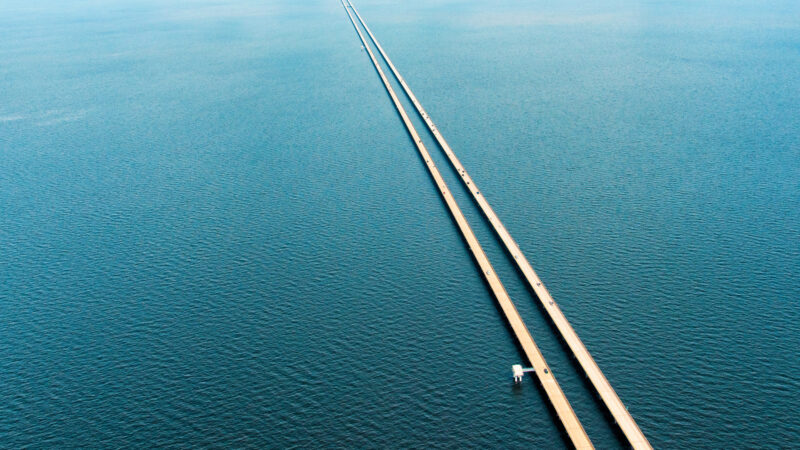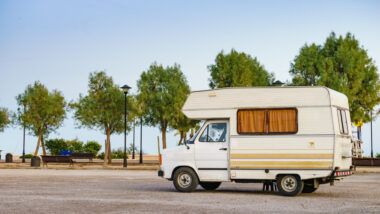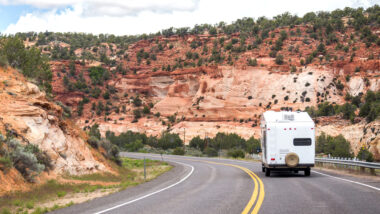Table of Contents Show
Driving over a bridge in any vehicle can be a terrifying experience for some or even induce a panic attack. It may seem common sense if you’re one of them, but you’ll want to avoid the longest bridge in the USA. It may send your nerves past their breaking point!
Some brave drivers may consider hauling their RV across long bridges. But can you drive an RV over the longest bridge in the USA?
Today, we’ll help you decide whether or not this could be your next RVing adventure. Buckle up, and let’s get started!
What Is the Longest Bridge in the USA?
The longest bridge in the USA is the Lake Pontchartrain Causeway. It spans 23.83 miles across Lake Pontchartrain in southern Louisiana.
And it’s a critical transportation link between Mandeville and Metairie, a New Orleans suburb. Not only is it the longest bridge in the USA, but it is also the world’s longest bridge over a body of water.
The Lake Pontchartrain Causeway carries nearly 12 million vehicles per year. The bridge has become a popular tourist attraction, and many people consider it one of the engineering marvels of the United States.
About the Lake Pontchartrain Causeway
We have Philip N. DeLamore to thank for all 23.83 miles of the Lake Pontchartrain Causeway. Construction on the southbound lane started in 1955 and wrapped up after 14 months in 1956. On the other hand, construction on the northbound lane didn’t start until 1967, and it opened in 1969.
It was worth the wait for drivers since it provided a faster and more efficient route across the lake. Drivers could shave off approximately 50 minutes from their commutes to and from New Orleans.
The bridge and its 9,000 concrete pilings and 9,500 concrete spans can withstand hurricanes and other severe weather. It features a high-tech monitoring system to help engineers constantly monitor the bridge for potential issues.
It has six safety areas throughout the 23 miles of the bridge. Drivers who experience an emergency should use these safety areas. Officials state these areas have helped reduce rear crashes by approximately 30%.
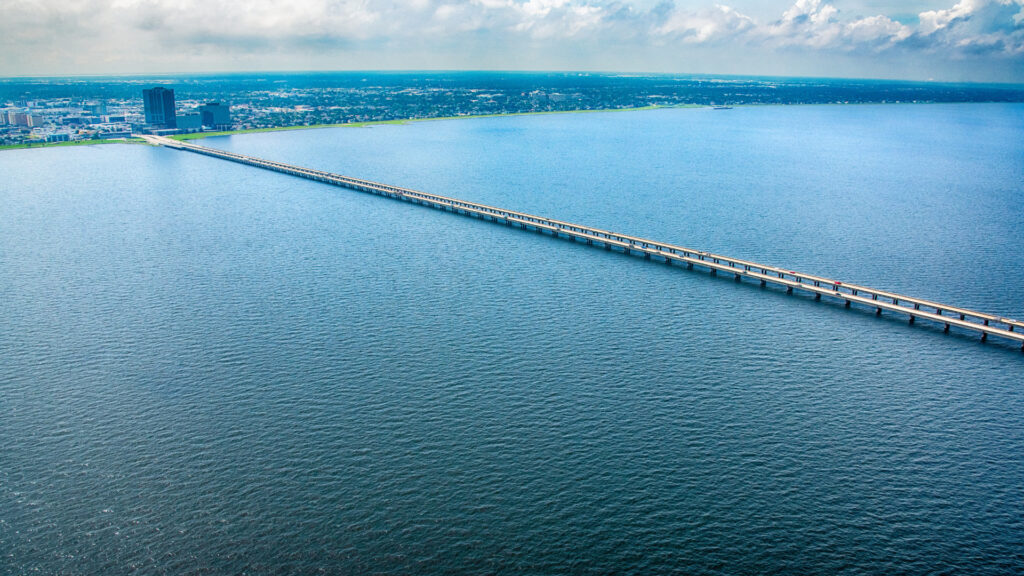
How Much Does It Cost to Cross Lake Pontchartrain Causeway?
Unfortunately, the Lake Pontchartrain Causeway is a toll road. However, tolls only get collected on the Mandeville side of the lake for vehicles heading south. Tolls get charged by the number of axles on the vehicle.
All two-axle vehicles cost $5, but those registering with the GEAUXPASS network can get a discounted rate of $3.
Fees increase with the number of axles and the height of the vehicle. They can range from $7 for those with three axles to $23 for vehicles more than seven feet tall with more than seven axles.
These can change with or without notice. Check the causeway’s website for the most up-to-date toll fees.
Can You Drive an RV Over the Lake Pontchartrain Causeway?
Thankfully, you can drive an RV over the Lake Pontchartrain Causeway. However, it has some restrictions and guidelines that you must follow.
The Lake Pontchartrain Causeway Commission states that RVs and other oversized vehicles must follow certain guidelines to ensure the safety of all drivers and passengers.
Unless you have some incredibly massive RV we’ve never seen, you’ll be okay with the maximum gross weight, height, and length limits. You’ll likely not weigh over 88,000 pounds, be taller than 14 feet 6 inches, or be longer than 65 feet. If you are, you’ll likely have problems long before you arrive at the bridge.
Unfortunately, the bridge can restrict traffic due to high wind conditions, especially for large vehicles. It’s a good idea to check the weather and the bridge’s status if your route takes you across it.
Famous Bridges in the United States That Are RV-Friendly
The Lake Pontchartrain Causeway is the longest bridge in the USA, but it isn’t the only famous one that’s RV-friendly. Let’s look at a few others you can haul your rig across during your travels.
Chesapeake Bay Bridge-Tunnel (Virginia)
The Chesapeake Bay Bridge-Tunnel is a 17.6-mile bridge and tunnel that crosses the Chesapeake Bay. It connects Delmarva and Hampton Roads. The northbound lane opened in 1964, and the southbound lane opened in 1999.
If you drive in an RV, it’s important to note that both tunnels have a height restriction of 13 feet 6 inches and that you must turn off your propane before crossing. If you’ve never measured your RV, now is as good a time as any to check.
This is another route that weather can severely impact. However, the wind can cause closures, forcing you to find a much longer alternate route. Make sure you check for any weather or traffic closures.
The Chesapeake Bay Bridge-Tunnel is another toll road. However, the toll fees vary considerably and depend on the type of vehicle, the number of axles, and when you travel.
Fees can range from $14 to $29 for passenger vehicles. Additionally, you can get discounts for the return trip if it’s within 24 hours and if you use an E-ZPass transponder.
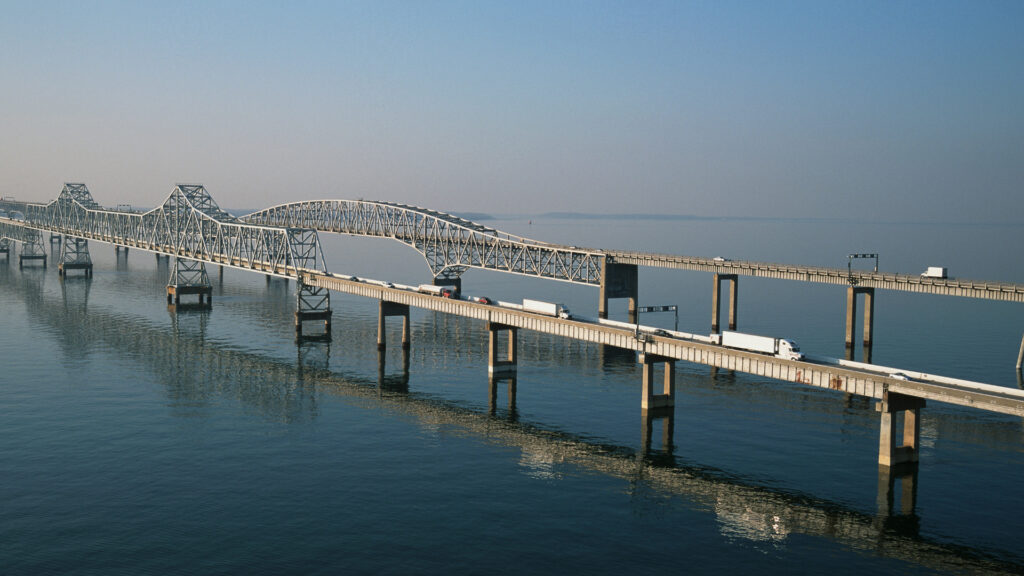
Golden Gate Bridge (California)
What better way to explore the Golden Gate Bridge than in an RV? It’s one of the most iconic bridges in the USA and extends 1.7 miles.
The Golden Gate is a toll bridge, but tolls only get collected for southbound traffic. Tolls can range from $8.40 to $65.85, depending on how many axles you have and how you pay for the toll.
The Golden Gate Bridge Highway and Transportation District requires trailers to use the curb lane, which is the right traffic one. These 11-foot lanes are slightly wider than the other 10-foot-wide ones.
Also, lanes #1 and #2 are roomier toll plaza lanes for wider vehicles. Remember that it has height restrictions of 14 feet 6 inches.

Mackinac Bridge (Michigan)
The Mackinac Bridge is a 5-mile-long suspension bridge that spans the Straits of Mackinac. It separates Michigan’s upper and lower peninsulas and connects St. Ignace to Mackinaw City. Crossing the Mackinac Bridge in any vehicle can be an incredible experience, especially in an RV.
Like many of the bridges we’ve shared, weather can be a problem with this bridge. From time to time, it does get closed, or traffic gets restricted. They regularly adjust the speed based on the winds, so pay close attention.
This is another toll bridge, but it’s not nearly as expensive as others. Passenger vehicles get charged $2 per axle or $4 per car. It’s much more budget-friendly than many of the other bridges.
Keep in Mind: Are you planning a cross country road trip this summer? Then you need to add these stops to your trip!

Tips for Driving RVs Over Bridges
Safety is important when driving an RV over a bridge. You can’t take it lightly, whether you get nervous or not. Here are a few tips to help you and your RV cruise over any bridge smoothly.
Check Weather Conditions
Weather, especially high winds, can often be a serious issue around large bridges. A powerful and unexpected wind guest can easily push an RV from one side of the road to the other. While some bridges will restrict traffic during these conditions, that’s not always the case.
You should check the weather anytime you travel in an RV, especially if it involves crossing a bridge in the USA. Sometimes it’s best to pull over, find a safe parking place, and wait for the winds to calm.
If you’ve ever driven in high winds, you know how dangerous it can be. Some rigs experience issues with the wind more than others, but winds above 25 miles per hour will impact most drivers.
Know Your Height
Low clearances are not something you want to take lightly in an RV. Knowing your height can help you avoid a serious situation and damage to your rig. If not, you may have to replace your RV air conditioner.
You can’t take the manufacturer’s word for your rig’s height. Measure the exact height of your RV while hitched to your tow vehicle. This could change the size the manufacturer gives for your rig by a couple of inches.
Measure from the ground to the tallest point on your trailer. Don’t forget to include the height of the air conditioning units. These can add more than a foot to the overall height of your rig.
Pro Tip: You have a responsibility to Know Your Total RV Height Clearance. Click the link to learn more RV height!
Don’t Forget Tolls
Unfortunately, the highway departments that run the bridges have to fund their construction and maintenance. They cover these expenses by charging drivers tolls each time they cross. The fees will vary based on the bridge, but crossing in an RV can be expensive.
Many bridges charge drivers based on their number of axles. The costs can increase significantly if you have a dual or triple-axle trailer.
The northeast has some bridges that cost $10 to $15 for standard passenger vehicles. However, those towing a fifth-wheel or travel trailer get hit with a $25 to $30 toll. Yikes!
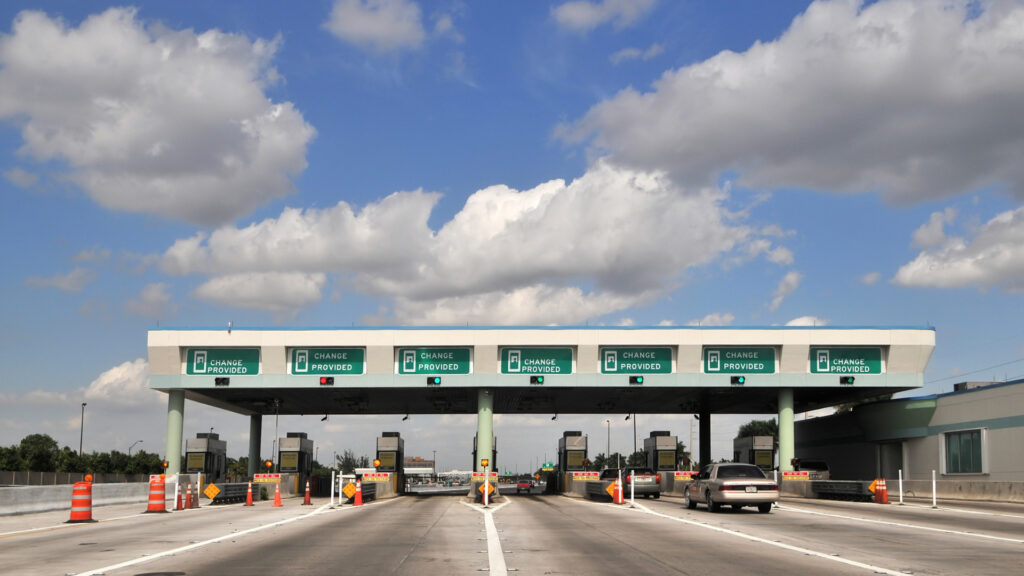
Stay in Your Lane
Some bridges restrict oversized vehicles, including RVs, to certain lanes. Typically, this is the right traffic lane, but it can vary based on the bridge. Ensure you note any signage indicating where you should drive.
Changing lanes on a bridge is typically never a good idea. Stay in your lane until you safely cross the bridge. You don’t want to make a mistake or cause an accident while driving over a long bridge in the USA. It is dangerous and will cause a serious delay for you and other drivers.
Watch Your Speed
Additionally, never speed in an RV, especially when crossing a bridge. Take note of the speed limit signs, as some routes may have reduced speeds.
In addition, some bridges use electronic speed limit signs and adjust the maximum speed limit based on the weather conditions.
Being in a hurry while RVing can be extremely dangerous. Take your time crossing the bridge, and you’ll stand the best chance of making it safely to the other side.
Should You Drive an RV Over the Longest Bridge in the USA?
Several million drivers travel over the Lake Pontchartrain Causeway annually, including many RVers. Generally, it is an extremely safe bridge, and there’s no reason to worry.
Due to the advanced technologies of many of these bridges, they’re some of the safest pieces of road. Buckle your seat belt, take a deep breath, and know you will safely reach the other side.
Have you ever driven across the longest bridge in the USA? Would you ever drive an RV across?




